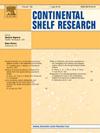从海鳗耳石中揭示美国南卡罗来纳州和佐治亚州外大陆架痕量金属的来源和迁移途径
IF 2.1
3区 地球科学
Q2 OCEANOGRAPHY
引用次数: 0
摘要
斑海鳝(Gymnothorax moringa)是南卡罗来纳州和佐治亚州邻近外大陆架水深 30-70 米处硬底礁的非迁徙性居民,对其耳石中的痕量金属浓度进行了分析,以确定分析结果是否有助于深入了解该大陆架动态区域的痕量金属来源和迁移过程。锂和镁似乎反映了通过鳗鱼栖息的邻近多孔岩石露头循环的当地海水的暴露情况。耳石中锰、钒、铜和锌的浓度似乎与沿大陆架断裂上涌的深水有关。根据 30 年来的渔业调查水温数据,位于北纬 32.30 度、水深 50 米左右的斯坎普海脊的夏季底部温度明显低于大陆架边缘的其他地方,这表明该处的局部上升流增强。在斯坎普海脊附近采集的鳗鱼耳石中,铜和锌的含量最高,锰和钒的含量最低。这些结果表明,鳗鱼的耳石化学成分可以揭示美国东南海岸外大陆架水团输入的细微结构。本文章由计算机程序翻译,如有差异,请以英文原文为准。
Sources and transport pathways of trace metals to the outer continental shelf off South Carolina and Georgia, USA revealed from the otoliths of moray eels
Trace metal concentrations in otoliths of spotted moray eels (Gymnothorax moringa), non-migratory residents of hard bottom reefs at depths of ∼30–70m along the outer shelf adjacent to South Carolina and Georgia, were analyzed to determine if results provide insights into trace metal sources and transport processes in this dynamic region of the shelf. Li and Mg appear to reflect exposure to local sea water circulated through adjacent porous rock outcrops where the eels reside. Concentrations of Mn, V, Cu, and Zn in otoliths appear to be associated with deep water upwelled along the shelf break. Based on 30 years of water temperature data from fishery surveys, Scamp Ridge, located at 32.30 N at a depth of ∼50m, has significantly lower summertime bottom temperature than elsewhere along the shelf edge, indicating locally enhanced upwelling at that location. The highest levels of Cu and Zn and the lowest of Mn and V were also found in otoliths of eels collected in the vicinity of Scamp Ridge. These results indicate that otolith chemistry in eels can reveal fine-scale structure of water mass inputs to the outer shelf of the southeastern US coast.
求助全文
通过发布文献求助,成功后即可免费获取论文全文。
去求助
来源期刊

Continental Shelf Research
地学-海洋学
CiteScore
4.30
自引率
4.30%
发文量
136
审稿时长
6.1 months
期刊介绍:
Continental Shelf Research publishes articles dealing with the biological, chemical, geological and physical oceanography of the shallow marine environment, from coastal and estuarine waters out to the shelf break. The continental shelf is a critical environment within the land-ocean continuum, and many processes, functions and problems in the continental shelf are driven by terrestrial inputs transported through the rivers and estuaries to the coastal and continental shelf areas. Manuscripts that deal with these topics must make a clear link to the continental shelf. Examples of research areas include:
Physical sedimentology and geomorphology
Geochemistry of the coastal ocean (inorganic and organic)
Marine environment and anthropogenic effects
Interaction of physical dynamics with natural and manmade shoreline features
Benthic, phytoplankton and zooplankton ecology
Coastal water and sediment quality, and ecosystem health
Benthic-pelagic coupling (physical and biogeochemical)
Interactions between physical dynamics (waves, currents, mixing, etc.) and biogeochemical cycles
Estuarine, coastal and shelf sea modelling and process studies.
 求助内容:
求助内容: 应助结果提醒方式:
应助结果提醒方式:


